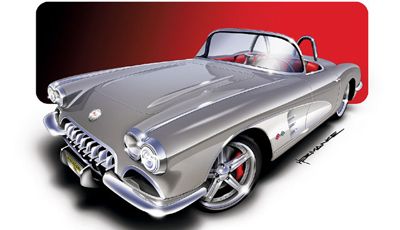
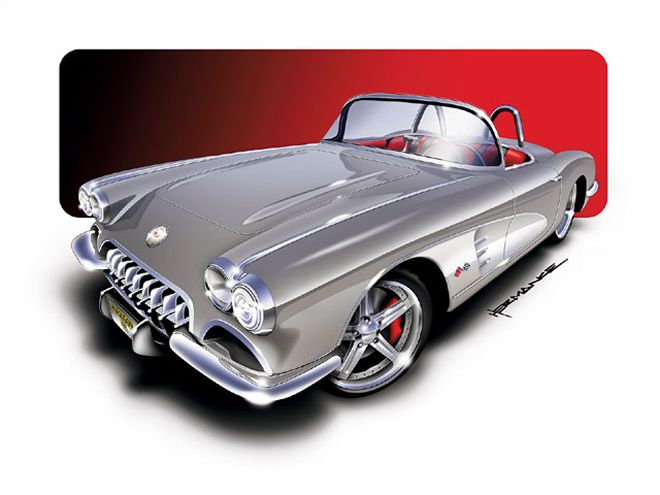
Last month, we introduced our '60 Corvette project car, Project 3G Vette, and laid out the goal: Make at least 1g of performance in the lateral axis, in acceleration, and in deceleration. Those are the 3 "g's" in 3G. The crew at Art Morrison Enterprises designed and built the C1's prototype GT Sport chassis using original drawings from GM, making improvements to the suspension geometry, and incorporating modern C5/C6 suspension components. They also designed the GT Sport chassis to accommodate larger wheels and tires for those customers who plan to use their cars to the fullest. In part two, we'll take a look at the powertrain needed to propel the 3G Vette to those planned 1g+ acceleration runs. Without giving away the final results, we can say this powerteam was more than up to the task, as we shall find out in a few more installments.-Johnny Hunkins
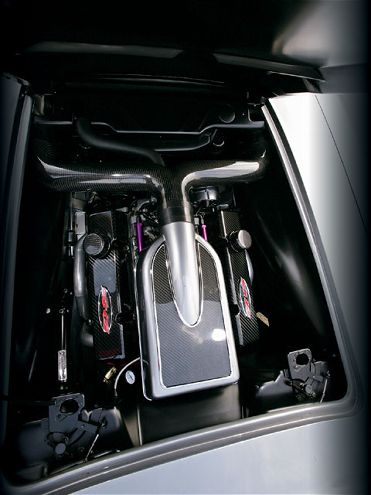
Now that the foundation of our 3G Vette has been laid, it's time to focus on obtaining the power for the second "g" of our quest: acceleration. To achieve this goal, we need a lightweight, yet powerful engine that can give us the acceleration we require, while maintaining the overall stability and balance of the car. The rest of the drivetrain has been analyzed in a similar fashion, with components being selected that could contribute to the greater good of the overall goal of acceleration, cornering, and braking. Thanks to the original Corvette design, we did have one great advantage over other body styles of the 1960s: the engine placement is well behind the spindles, which dramatically improves the overall balance of the car. To further this performance balancing act, it's imperative the engine remain as light as possible, yet still offer plenty of power and long-distance reliability.
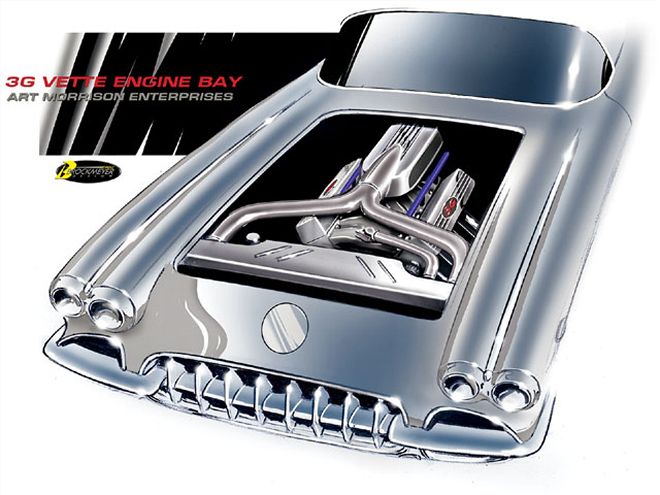 Our engine bay rendering was done by Eric Brockmeyer. When working off of a rendering, it is much easier to keep a consistent theme and vision throughout the construction of a car.
Our engine bay rendering was done by Eric Brockmeyer. When working off of a rendering, it is much easier to keep a consistent theme and vision throughout the construction of a car.
So which engine to use? While this is another hotly debated chatroom topic, there truly is no correct answer. It can usually be narrowed down to a few different options, but personal preference definitely weighs heavily on this one. Here's how we came up with our decision: Because of weight concerns and a very low-profile engine compartment, big-blocks were ruled out immediately. Then it was down to the LS engines and traditional small-blocks. Again, because of weight concerns, all iron-block engines were removed from the list. Once the list was narrowed to only a few choices, we could consider cost, horsepower, and finally, personal preferences. Our final choice was the all-aluminum 427-inch SBC from World Products, producing 550 hp and 525 lb-ft of torque, and weighing just 355 lbs.
The foundation for this engine is World Products' Motown Lite aluminum engine block. Cast to World Products' specs, it features horizontal ribs on the outside of the block and internal ribs that also cross-feed the lifter bores. The sides of the engine block are also bulged out to increase the amount of water cooling to the cylinders. It is an extremely strong yet lightweight piece that weighs in at a paltry 100 lbs, and that includes the sleeves and billet-steel splayed main bearing caps. The cylinder heads are also a World Products design from the Motown Lite family. The main features of these heads are high-flow 220cc intake runners and 64cc combustion chambers that are CNC-machined using the latest high-swirl design. The rest of the build sheet reads like a dream list of what you would want to put in an engine you were building yourself. From 4340 H-beam rods, to coated pistons and a 4340 forged crankshaft, the World Products Hardcore 427-inch SBC is definitely built to withstand some serious punishment. Before the engine is shipped out, it is run in on World Products' in-house DTS engine dyno. Run on 87-octane fuel to ensure it will operate on any fuel out there, our particular engine made a solid 550 hp. It's no wonder World Products offers a two-year unlimited-mile warranty on this, and the rest of its street engines.
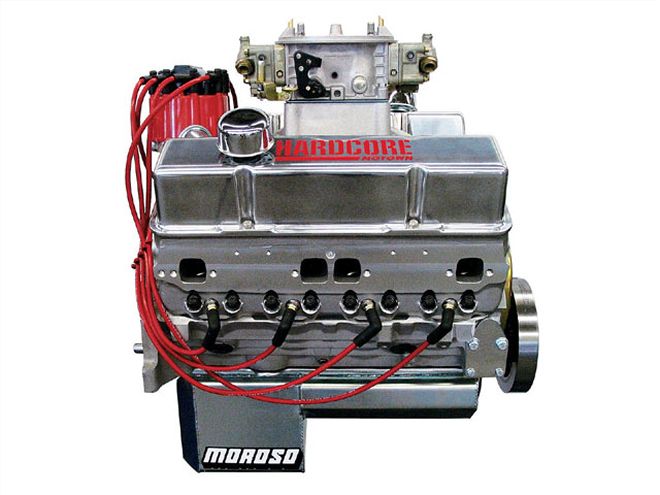 The power for Project 3G Vette is from a Bill Mitchell Hardcore all-aluminum 427-inch SBC crate engine.
The power for Project 3G Vette is from a Bill Mitchell Hardcore all-aluminum 427-inch SBC crate engine.
Because of the extremely low-profile nature of the C1 Corvette's engine bay, the Dominator carburetor was replaced with a hood-friendly, modern fuel-injection setup. The Weiand Team G manifold was modified for fuel injection by the folks at Wilson Manifolds, and included their throttle body spacer and 1,200-cfm billet throttle body. A set of Wilson fuel rails and Bosch injectors rounded out the package. One of FAST's XFI Electronic Fuel Injection Systems was used to control engine functions, and allow for precision tuning. To ignite the fuel, a combination of an MSD distributor, coil, and ignition box produces the spark. An Aeromotive compact EFI regulator maintains the fuel pressure. Red Line oil was used to ensure maximum performance and longevity, while an SFI-rated Fluidampr balancer eliminates potentially harmful harmonics. To ensure the combination worked before it was installed in the Vette, the engine was taken to the dyno. Using the Corvette's headers and head pipes, the engine produced at 538 hp and 517 lb-ft of torque. Only 12 hp and 8 lb-ft separated the two tests, which was pretty remarkable, since the testing was done on different dynos with different headers and full engine dress.
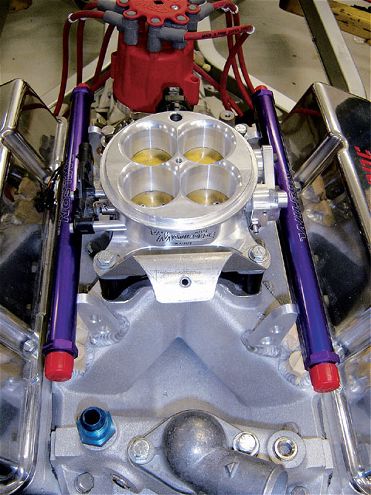 In order to keep things under the original hood, the Dominator carburetor was replaced with a Wilson Manifolds throttle body and spacer, and a set of Wilson fuel rails.
In order to keep things under the original hood, the Dominator carburetor was replaced with a Wilson Manifolds throttle body and spacer, and a set of Wilson fuel rails.
To take advantage of this power and maximize the acceleration potential of this potent combination, the decision was made to use an aluminum flywheel, clutch, and bellhousing from McLeod. The lightweight flywheel will allow the engine to rev quickly while the dual-disc clutch provides more than enough grip to transfer the power to the transmission and rear wheels. This new universal bellhousing allows for the non-GM transmission to be used, and it's also SFI-approved for extra safety. To disengage the clutch during shifts, a McLeod hydraulic throw-out bearing is also used.
Mated to this bulletproof combination is an equally tough Rockland Standard T56 six-speed. Rockland Standard Gear is familiar with building bulletproof high-horsepower transmissions, and it's no wonder most of the professional teams in Grand-Am Road Racing, Speed World Challenge, and SCCA competitions use their products. While the stock Viper T56 six-speed is tough, Rockland Standard makes them even tougher. The transmission has been upgraded with steel 3-4 shift forks, carbon fiber synchro rings, and solid synchro keys. During assembly, all components are match-fitted and blueprinted. Brand new OEM bearings are also used throughout, and the transmission is performance shimmed. The result is a road-race ready transmission that is unbelievably smooth shifting through all six gears. Although the transmission isn't the lightest one out there, the weight is centralized in the vehicle, helping with the overall weight balance of the car. With great low gears, beefed up internals, and a close-ratio double overdrive, this transmission really does offer the best of both worlds-great acceleration and high speed, with highway-friendly cruising.
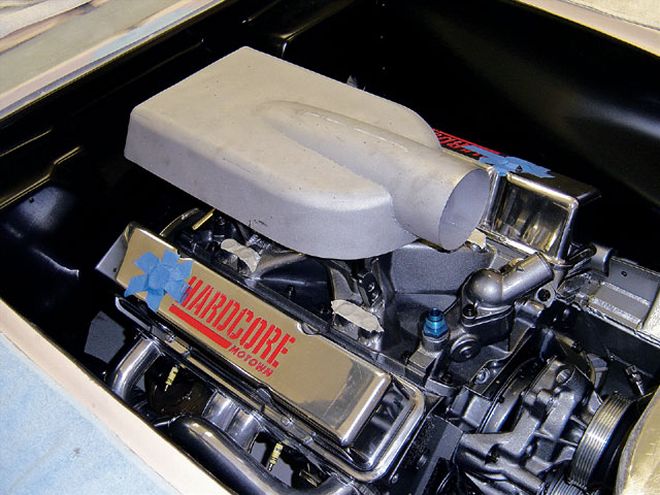 Because hood clearance was an issue with this car, the airbox was built and trial fit numerous times while the engine was in the car.
Because hood clearance was an issue with this car, the airbox was built and trial fit numerous times while the engine was in the car.
Finally, transmitting that power to the pavement is the Art Morrison Enterprises 9-inch housing. Starting with a Currie 9+ third member, AME installs its own axle tubes, CNC-machined housing ends, and suspension bracketry. All of the housing's internals are from Strange Engineering, a company very familiar with building high-quality, high-performance components. Beginning with the third member, a Strange "S" case was used. With its radial-ribbed design and nodular-iron construction, it's the perfect foundation for a bullet-proof differential. Within this S case is an all-new posi-traction unit and a set of Strange machined gears. For this particular application, we used a 3.70 ratio, based on our tire size, final drive in the transmission, and desired cruising rpm. Linking the tires to the differential is a set of Strange S/S 31-spline induction-hardened axles. Induction hardening is a process that uses an electric coil to first heat, then quench, the axle shaft. This produces a hard case, while leaving the core and flange soft, resulting in a very ductile axle. This type of hardening has been used on production vehicles for decades, and it's perfectly designed for the bending loads an axle sees during high-performance street driving. To keep everything lubricated and as free as possible, Red Line gear lube was employed.
Power, weight, and acceleration. It's a tricky combination. You need just the right amount of power to achieve the acceleration goal without adding too much weight, which would in-turn hurt the overall balance of the car and hinder cornering performance. With proper planning and the overall goal in sight through the construction process, it can be done.